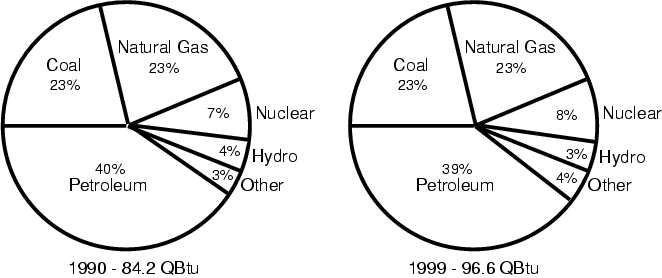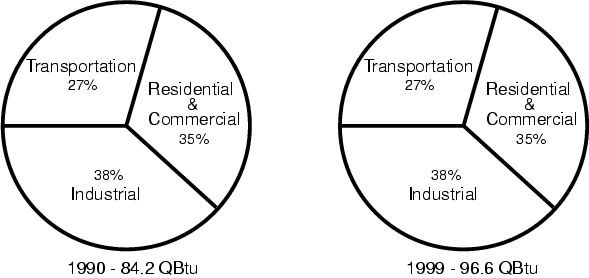Energy is used for many different
purposes:
 to heat ourselves,
to heat ourselves,  to cool ourselves,
to cool ourselves,  to cook,
to cook,  to move from one place to another.
to move from one place to another.Lecture V
Energy is used for many different
purposes:
 to heat ourselves,
to heat ourselves,
 to cool ourselves,
to cool ourselves,
 to cook,
to cook,
 to move from one place to another.
to move from one place to another.
Where does this energy come from?

Energy may be deployed in a number of ways or end uses.

Electricity
 is generated from our natural
resources.
is generated from our natural
resources. is central to our national energy
policy.
is central to our national energy
policy. we must discuss both production and end use.
we must discuss both production and end use.
it costs 1kWh of energy from
hydro or photovoltaic sources to produce
1kWh of electric energy.
 there are two units
kWhe and
kWht which may be chosen
to report energy.
there are two units
kWhe and
kWht which may be chosen
to report energy.
 We need some way to
account for this
We need some way to
account for this
 We must discuss
efficiency
We must discuss
efficiency
Space heat is the single largest
end use in
 the residential and
the residential and  commercial sectors.
commercial sectors.
 Conservation measures here
will make a difference.
Conservation measures here
will make a difference.
Other end uses in the residential sector include:
 space heat
space heat water heat
water heat cooking
cooking refrigeration
refrigeration air conditioning
air conditioning Our lives would not be the
same without electricity.
Our lives would not be the
same without electricity.
Air conditioning helped settle the Sunbelt!
Ohio's Greatest Home Newspaper |
Sunday, October 4, 1998 |
State becomes first to offer a choice of energy sources Sunday, October 4, 1998 Martha Bellisie
TEHACHAPI, Calif. -- The three-bladed propellers play an eerie wind waltz - a steady whoosh, whoosh, whoosh - as the persistent breeze blows. The sleek, angular towers, reaching up to 140 feet, stand like sentries guarding the grassy hillsides that lead to California's high desert. ``To me, they look like giiant toy pinwheels flickering in the afternoon sun,'' said Geraldine Veatch, who lives just west of Tehachapi Pass, where more than 4,900 wind turbines spin out enough energy anually to power 250,000 homes. ``Some say they're an eyesore. But I'd rather have wind turbines than nuclear power plants.'' California is the birthplace of wind power in the United States. It's also the first state to let consumers choose the source of the electricity they use. Now the rest of the country is watching to see how wind farms and other pollution-free, or ``renewable,'' energy producers fare in a competive marketplace. Power sources considered renewable include wind, solar, geothermal, biomass (electricity produced by burning garbage) and small hydroelectric plants (which don't significantly impact wildlife and water). Before March 31, a handful of utilities held a monopoly on the state's $20 billion power industry. The system made sense, given the high cost of producing and transmitting electricity and the need for reliable electricity in this energy-dependent age. But California's deregulation legistration, passed in 1997, opened the market in the same way the airlines and long-distance phone industries were restructured. ``Deregulation actually doesn't have anything to do with the flow of electricity, it has to do with the flow of money,'' said Rich Ferguson, spokesman with the Sacramento-based Center for Energy Efficiency and Renewable Technologies. ``You used to have to give all your money to the monopoly utility. Now you can choose an independent supplier.'' Whether consumers will use their buying power to demand lower prices or whether they'll be willing to actually pay more for nonpolluting choices of electricity genreation are unanswered questions. About 69,000 residential customers have switched their power providers from utilities to independent suppliers since the program started late last year, according to California Energy Commission spokeswoman Claudia Chandler. But the utility industry is not yet able to determine how many of those customers chose renewable power sources, Chandler said. Ferguson said the majority were likely green switches. ``It's the biggest factor in the competitive market,'' he said. ``Prices aren't a strong marketing factor at this point.'' Several high-profile companies have gone green. Patagonia, a Venture-based outdoor clothing company, announced recently that it has committed to using 100 percent wind energy to power its 14 California facilities. ``We decided, as a company, to participate in eliminating, or reducing the dirty power that's on the grid by replacing it with clean power,'' said Patagonia spokeswoman Lu Setnicka. But the company won't be going off the grid and running power lines direct to wind turbines. Instead, it has contracted to buy its electricity from Enron Energy Services. Enron is building a 16-megawatt wind farm near Palm Springs to accomodate the contract. Toyota Motor Sales also committed to using a mix of renewables - including wind ,solar and geothermal - to power its Torrance and Irvine headquarters. The division also is working on switching over to renewable energy at its Long Beach docking facility and an auto parts supply facility. California electric customers can call an independent power source and choose from a variety of packages. For instance for an extra $7.45 to $16.90 a month, consumers can choose a package from Southern California Edison's Earthsource 50 or 100 programs, offering power that is either 50 percent or 100 percent from renewable sources. |
Electricity Needs are defined in terms
of load: See Energy Figure 6.3
 Base load
Base load
 Intermediate load
Intermediate load
 Peak load
Peak load
See Energy Figure 6.5, 6.8
Surface area goes as r2, but volume goes as r3. If the cost goes as the surface area
 the bigger the building the
cheaper the usable space
the bigger the building the
cheaper the usable spaceBut bigger costs more to get started. The result is that most
utilities use a mixture of generating facilities to satisfy demand.
See Energy Figure 6.5, 6.8
What to do Next?
How should we approach the future needs of electrical energy?
 build more plants
build more plants build larger plants
build larger plants co-generate electricity
co-generate electricity use renewable sources
use renewable sources increase efficiency
increase efficiency cut transmission losses
cut transmission losses
Problem of the day A population of cows on a farm is in steady state. The birth rate
is 7 calves per year and the average residence time for a cow on the
farm is 6 years. How large is the herd? When the flow of a substance into a herd, lake, atmosphere or other
box is equal to the outflow of the substance, then the amount
or stock of that substance in the box will be constant. This
is called a steady state or equilibrium. In this
condition the ratio of the stock in the box to the
flow rate (in or out) is called the residence time. Thus if Fin is the rate of inflow to the box and
Fout is the rate of outflow, the steady state
condition is: Fin = Fout Letting M be the stock and T be the residence time then M/Fin = M/Fout
= T
Solution What do we know?
 The residence time, T,
is 6 years
The residence time, T,
is 6 years
 The inflow, Fin,
is 7 calves/year
The inflow, Fin,
is 7 calves/year
 The stock, or how large the
herd is, M is unknown
The stock, or how large the
herd is, M is unknown
so:
M/Fin = T
or
M = T x Fin
M = 6 yrs x 7 cows/yr = 42 cows